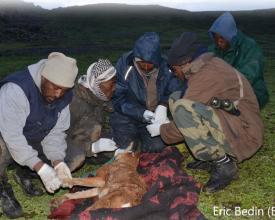Managing disease in Ethiopian wolves

Ethiopian wolves (Canis simensis) are Africa’s most endangered carnivore, with approximately 500 individuals remaining along the country’s Afroalpine habitat, approximately half of which are found in the Bale Mountains. While habitat loss is a major threat to species survival, infectious disease epizootics have had serious impacts on wolf populations. Since 1992, the wolves in the Bale Mountains have faced eight major outbreaks from rabies and canine distemper viruses. Outbreaks are prompted by introduction of the viruses from domestic dogs. The density and social nature of the wolves allow for rapid virus transmission amongst and between packs; concerningly, outbreaks have resulted in extinctions of entire packs. To effectively manage this threat, the Ethiopian Wolf Conservation Programme and its partners have developed and applied a comprehensive conservation strategy, including preventive and reactive vaccination and disease monitoring in line with a One Health approach.
Context
Challenges addressed
The presence of unvaccinated domestic dogs is compounded by habitat loss, bringing people, domestic animals, and wildlife closer together and creating opportunities for disease transmission.
Location
Process
Summary of the process
The Ethiopian Wolf Conservation strategy involves many components and stakeholders. The disease management aspect has a foundation of scientific evidence and awareness, which has informed an integrated disease management strategy, including detection and vaccination. As rabies presents a serious threat to the health of humans, domestic animals, and wildlife alike, this solution reinforces how conservation can generate important One Health benefits.
Building Blocks
Evidence and Awareness
As part of the conservation strategy, government agencies, protected area managers and local communities are informed of the threat imposed by diseases on the wolves and how to minimise it, leading to stakeholders becoming more actively engaged in controlling disease risks. The conservation strategy is based on and contributes to the scientific evidence base for canid conservation and disease management. The awareness focus of the initiative ensures community members understand why domestic dog vaccination is important and the value of reporting disease observations.
Enabling factors
Coordination with government partners and other stakeholders ensures ongoing exchange of information. Everyone is aware of the threats faced by the wolves and shares the common goal of protecting them. Community members play important stewardship roles, including as wolf ambassadors and community guards.
Lesson learned
The vaccination of wolves was a novel approach in the continent. Knowledge exchange with government partners and national and international disease experts ensured the latest scientific guidance was available and considered in decisions important to the survival of wolf populations and the species. EWCP’s approach is informing best practices for disease management in conservation.
Vaccination
To be effective, vaccination campaigns in domestic dogs have to achieve and maintain 70% coverage, which presents a practical challenge in a remote landscape with a high turnover in the dog population. Under the EWCP initiative, a comprehensive approach is taken to prevent and prepare for disease introduction and spread in wolf populations: vaccination campaigns are carried out in domestic dogs in and around wolf habitat, preventive oral vaccination of wolves is conducted, and emergency vaccination of wolves is administered in response to a confirmed disease epizootic.
Enabling factors
Research, including a successful field trial, resulted in the EWCP being able to conduct preventive vaccination of wolves against rabies using an oral bait (a vaccine sachet hidden inside a piece of meat). Oral vaccination is cheaper, less stressful for wolves, and easier to scale up than injectable vaccines.
Lesson learned
While the injectable rabies vaccine is used routinely in domestic dogs around the world, successful vaccination in wolves required a different approach: oral rabies vaccination. While oral baiting approach is used in some wild carnivores in North America and Europe, this was the first time that the SAG2 rabies vaccine was used in an endangered species. Trials were conducted on bait preferences and vaccine delivery in wolf populations in the Bale Mountains.
Detection
Through monitoring efforts, diseases among wolves are detected at an early stage, diagnostic capacity is improved, and interventions can be implemented as soon as possible, saving the lives of many wolves. Through our integrated disease management initiative, we provide training and technical manuals for local veterinary staff and develop Disease Alert Networks to improve the ability to detect, diagnose, and contain outbreaks in wolves and dogs.
Enabling factors
A team of highly trained monitors, working on foot or horse-back, closely observe wolf packs. During outbreaks, they are the first to detect dead wolves, and swiftly conduct post-mortems and collect diagnostic samples, while a wider network also alerts EWCP of outbreaks of rabies or distemper in dogs. The strengthening of laboratory systems and veterinary services are key enabling factor to support robust rabies detection and monitoring in the country.
Lesson learned
Many dogs roam freely in the rural highlands, where they encounter wolves and can transmit diseases. The presence of domestic dogs, paired with increased agricultural activity in the area, makes ongoing monitoring critically important to detect evolving threats and help guide appropriate conservation action. The awareness and participation of many stakeholders forms a vital network to support detection.
Impacts
As part of the Ethiopian wolf conservation strategy, an integrated disease management strategy for rabies and canine distemper has involved numerous key partners, including the Ethiopian Wildlife Conservation Authority and protected area managers, local governments, and communities. The plan includes five components: controlling diseases in reservoir dogs, reducing dog-wolf contact, increasing capacity to detect outbreaks, vaccinating wolves as a preventative measure and, (as a last resort) emergency vaccination of wolves in response to a confirmed epizootic. Specific indicators are tracked to continually evaluate the impact of the strategy, including the number of packs orally vaccinated against rabies, frequency of free-roaming dogs within wolf habitat, number of district and zonal staff trained and equipped to conduct wildlife post-mortems, and the number of villages reached by awareness campaigns. The EWCP routinely vaccinates 3,000-4,000 dogs a year against canine distemper and rabies in the settlements around wolf habitat in the Bale Mountains, to reduce the risk of them transmitting the virus to Ethiopian wolves, livestock and people. An overall indicator of the success of this work has been the down-listing from critically endangered to endangered on the IUCN Red List, based on an increase in wolf population numbers.
Beneficiaries
- Ethiopian wolves
- Communities living in/around landscape
- Other wildlife and domestic animals present in/around the ecosystem



